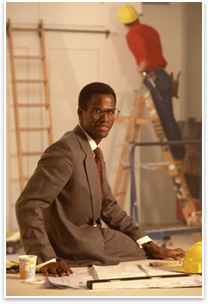Best Practices in risk management
Who Are You?
Defining the architect
by James B. Atkins, FAIA, and Grant A. Simpson, FAIA
 Summary: For some reason, the practice of architecture is generally not well understood outside the profession. As a result, the expectations of the public, building owners, and even contractors do not always align with actual outcomes. As the profession of architecture has evolved from the non-litigious days of the master builder, we have yet to shed the identity of being the only professional in charge. If people in general derive their understanding of architects from movies, consider the material available—from The
Fountainhead to The Towering
Inferno to Jungle Fever—it’s no wonder our identity is flapping in the breeze. Summary: For some reason, the practice of architecture is generally not well understood outside the profession. As a result, the expectations of the public, building owners, and even contractors do not always align with actual outcomes. As the profession of architecture has evolved from the non-litigious days of the master builder, we have yet to shed the identity of being the only professional in charge. If people in general derive their understanding of architects from movies, consider the material available—from The
Fountainhead to The Towering
Inferno to Jungle Fever—it’s no wonder our identity is flapping in the breeze.
Below is a synopsis of the article. For the full text, click on the PDF link located in the column on the right.
 Raising public awareness Raising public awareness
The AIA goes to respectable lengths to educate the public on architects and architecture. You and Your Architect is downloadable online, and addresses some of what an architect does as well as how to find and hire one. Yet many owners are under the misguided perception that architects are somehow automatically obligated to search out and find defects and deficiencies in the contractor’s work. We explored this topic in detail in the August 2006 AIArchitect article, “Absolute or Absolution.”
There often seems to be a false expectation that the architect has the preternatural ability to catch contractor mistakes and thereby prevent defects. Consequently, when problems are discovered in the completed work, the architect may be accused of causing construction defects, rather than the contractor who performed the work, in spite of the fact that the contractor provided an express warranty that the work would be free from defects.
 Convincing the contractors Convincing the contractors
Meanwhile, many contractors do not know much more about architects than owners do, especially if the architects they encounter issue insufficient or uncoordinated construction documents or take a passive approach to construction contract administration. Especially when architects are not visible on the job during construction, the contractor and owner cannot be aware of the services that an architect can provide. It was Woody Allen who said, “Eighty percent of success is showing up.” The importance of proactive construction administration was addressed in the June 2006 AIArchitect article, “Visible Means.”
 Anything but guaranteed Anything but guaranteed
Architects generally do a poor job when it comes to being open and forthwith about the risks inherent in designing and constructing a building. Whether it be the risk of increased costs or lengthened schedules inherent in the fast-track process (see “Managing Risk in Fast Track Projects,” Architect’s Handbook Update 2006) or the certainty of errors and omissions committed by the human beings who provide architectural services, architects are reluctant to talk about the things that can go wrong. Physicians and attorneys aren’t reluctant to set realistic expectations for their clients, while architects—wanting to be perceived likewise as respected professionals—are. Perhaps competition for commissions is a cause of this behavior in our profession.
Getting to know you
Make yourself completely available to the owner; subject him or her to your piles of bumwad sketches and countless red-marked drawings. When it comes to what we do, presenting laser-sharp wiz-bang technologies in the board room is a poor substitute for exposing your owner to the creative power and probing realities of the “back room” where we spend most of our time in search of our designs. If you are there, are responsive, and have answers, you can gain trusted-advisor status and actually demonstrate to the owner in real time what an architect is and does, as well as the limitations inherent in the process.
 We must primarily blame ourselves for the public’s misconceptions of what we do, and we must decide that we indeed want to be understood. On the way to your next coffee break, stop a few steps away and look back at your workspace. Contemplate how you would explain to your owner what you have been doing in the past hour. Explaining the benefits of your actions to the client and their project will reveal to them a little bit more about who you are. Go on now and get that cup of joe, and as you do . . . remember to be careful out there. We must primarily blame ourselves for the public’s misconceptions of what we do, and we must decide that we indeed want to be understood. On the way to your next coffee break, stop a few steps away and look back at your workspace. Contemplate how you would explain to your owner what you have been doing in the past hour. Explaining the benefits of your actions to the client and their project will reveal to them a little bit more about who you are. Go on now and get that cup of joe, and as you do . . . remember to be careful out there.
|


 Summary:
Summary: Raising public awareness
Raising public awareness Convincing the contractors
Convincing the contractors Anything but guaranteed
Anything but guaranteed We must primarily blame ourselves for the public’s misconceptions of what we do, and we must decide that we indeed want to be understood. On the way to your next coffee break, stop a few steps away and look back at your workspace. Contemplate how you would explain to your owner what you have been doing in the past hour. Explaining the benefits of your actions to the client and their project will reveal to them a little bit more about who you are. Go on now and get that cup of joe, and as you do . . . remember to be careful out there.
We must primarily blame ourselves for the public’s misconceptions of what we do, and we must decide that we indeed want to be understood. On the way to your next coffee break, stop a few steps away and look back at your workspace. Contemplate how you would explain to your owner what you have been doing in the past hour. Explaining the benefits of your actions to the client and their project will reveal to them a little bit more about who you are. Go on now and get that cup of joe, and as you do . . . remember to be careful out there.